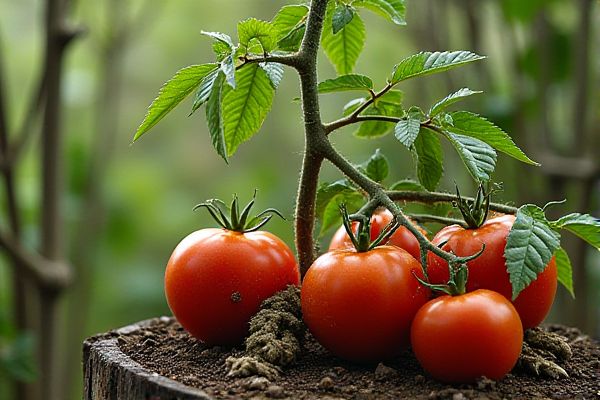
Stakes and cages both offer essential support for tomato plants, with stakes providing vertical stability for indeterminate varieties and cages offering all-around support to hold both the plant and fruit. Discover which method suits your gardening style and tomato type best to ensure Your plants thrive throughout the growing season by reading the rest of the article.
Table of Comparison
| Feature | Stakes | Cages |
|---|---|---|
| Support Type | Single vertical stake | Three or four-sided wire cage |
| Space Efficiency | Requires less ground space | Needs more space for placement |
| Plant Management | Easier to prune and tie branches | Less pruning needed, branches supported naturally |
| Assembly | Simple, usually wooden or metal stakes | Pre-fabricated or homemade wire cages |
| Durability | Can degrade or break over time | Typically durable and reusable |
| Cost | Generally low cost | Moderate to higher cost |
| Best For | Indeterminate tomatoes, small gardens | Indeterminate tomatoes, larger spaces, heavy plants |
Introduction: Choosing Support Systems for Tomatoes
Stakes provide individual support for tomato plants, promoting vertical growth and improving air circulation, which reduces disease risk. Cages offer more comprehensive support, containing sprawling branches and preventing fruit damage, ideal for indeterminate varieties. Your choice between stakes and cages depends on garden space, plant type, and the level of maintenance you prefer.
Understanding the Importance of Tomato Support
Tomato support significantly improves fruit quality and plant health by preventing sprawling and reducing the risk of disease. Using stakes or cages helps maintain proper air circulation and sun exposure, which enhances growth and yield. Choosing the right support for your tomatoes ensures stronger stems and easier harvesting throughout the growing season.
What Are Staking Methods for Tomatoes?
Staking methods for tomatoes include traditional stakes, cages, and trellises, each designed to support plant growth and improve fruit quality by preventing contact with the ground. Tomato stakes typically involve driving a wooden or metal pole into the soil near the plant and tying the main stem to the stake for vertical support. Cages are wire frameworks that surround the tomato plant, offering multi-directional support to branches, reducing breakage and promoting better air circulation.
What Are Tomato Cages?
Tomato cages are cylindrical or square frames made from metal or plastic designed to support tomato plants as they grow. They prevent sprawling by keeping the stems upright and help improve air circulation around the plant, reducing the risk of disease. Common sizes range from 18 to 30 inches in diameter and 24 to 48 inches in height, tailored to different tomato varieties and garden needs.
Pros and Cons of Staking Tomatoes
Staking tomatoes promotes better air circulation and reduces the risk of diseases by keeping plants upright and off the ground. It facilitates easier harvesting and supports larger fruit development but requires regular tying and maintenance to avoid plant damage. However, stakes can sometimes restrict growth space and may not support heavy, indeterminate varieties as effectively as cages.
Pros and Cons of Caging Tomatoes
Tomato cages provide sturdy support, promoting healthier growth and reducing the risk of fruit damage by keeping tomatoes off the ground, which also minimizes soil-borne diseases. However, cages can be bulky, more expensive, and harder to store compared to simpler stakes, potentially requiring more space in your garden. Your choice depends on the variety of tomatoes and garden layout, as cages work well for indeterminate plants needing continuous support, while stakes suit determinate types with shorter growth.
Comparing Growth and Yield: Stakes vs Cages
Tomato plants supported by stakes typically experience better air circulation and easier pruning, which can lead to higher fruit yield and faster growth compared to cages. Cages provide more comprehensive support for sprawling varieties, helping prevent fruit damage and reducing disease risk by keeping foliage off the ground. You can optimize your tomato harvest by choosing stakes for indeterminate varieties focused on vertical growth, whereas cages suit bushier types needing broader support.
Cost and Maintenance Considerations
Tomato stakes generally cost less upfront but require regular tying and pruning to keep plants upright, increasing your maintenance efforts throughout the growing season. Cages, while often more expensive initially, provide all-around support and reduce the need for constant adjustment, making them a low-maintenance option that can save you time. Choosing between stakes and cages depends on your budget and how much ongoing care you are willing to invest in your tomato plants.
Best Practices for Installing Stakes and Cages
For optimal tomato plant support, install stakes 2 to 3 feet deep and place them 4 to 6 inches from the base, ensuring stability throughout the growing season. Position cages early, surrounding young plants with a sturdy, 3 to 4-foot tall metal cage to promote vertical growth and reduce branch breakage. Secure stakes with soft ties and adjust cage placement as plants grow to maintain proper air circulation and sunlight exposure.
Which Method is Best for Your Garden?
Stakes provide strong vertical support, ideal for smaller gardens with limited space, allowing your tomato plants to grow upright and making harvesting easier. Cages offer more comprehensive containment, reducing the risk of branches breaking and supporting sprawling varieties, which is beneficial for larger or indeterminate tomatoes. Choosing between stakes and cages depends on your garden size, tomato variety, and how much maintenance you're willing to invest.
 homyna.com
homyna.com